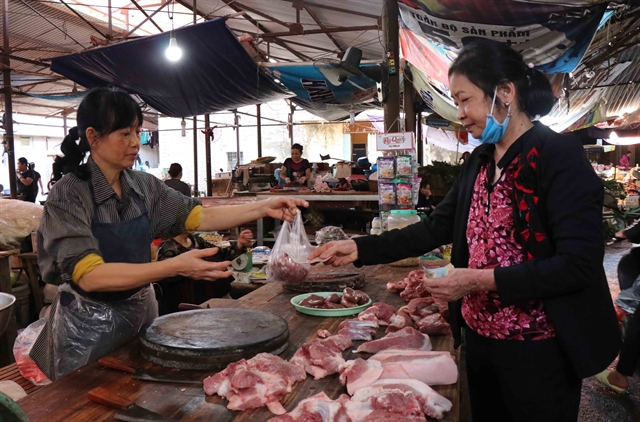 Society
Society


|
| A woman buys pork in Nhớn Market, northern Bắc Ninh Province. Pork prices have soared in recent months. —VNA/VNS Photo Thanh Thương |
HÀ NỘI — Soaring pork prices are making farmers reluctant to sell their pigs, worsening the current supply shortage.
Speaking at a conference on Thursday, Minister of Agriculture and Rural Development Nguyễn Xuân Cường pointed out the tactics farmers and traders use to take advantage of Việt Nam's demands for pork products, especially during the year-end.
“Even when a pig weighs 120kg they refuse to sell, wishing to raise it to grow as big as a buffalo,” he said.
“Traders hoard thousands of pigs from region to region, waiting for the prices to rise to their expectations. They even smuggle to China to enjoy higher prices."
The minister asked firms to work together to offer suitable prices for pork products to serve rising domestic demand ahead of Tết (Vietnamese Lunar New Year Holiday) and for exports.
The domestic pig breeding industry has had a bumpy year, Cường said, with productivity dropping 13.5 per cent compared to 2018.
African swine fever wiped out 9 per cent of Việt Nam’s pig herd.
According to the Department of Animal Health, there are some 25 million pigs including 2.7 million sows, mostly on big farms where standards of hygiene are maintained, making it possible to rebuild the pig herd.
Provinces of Hưng Yên, Hải Dương, Phú Thọ and Bắc Giang have seen their herds recover and 860 areas of biosafe pig farming have been established with investments from private firms.
“Pork production has attracted big corporations such as CP and Masan. Masan, for example, has opened hundreds of outlets for its cold meat products,” he said.
“The ministry has also urged localities to ensure food supply and safety during Tết,” he added.
Up to December 22, African swine fever had been newly reported in 23 communes with nearly 30,000 pigs culled. The number is predicted to reach 40,000 by the end of the year, down 74 per cent compared to November and 97 per cent compared to the outbreak's peak in May when some 1.27 million pigs were culled.
Facing the threat of food shortages as the disease spread, the Ministry of Agriculture and Rural Development (MARD) promoted poultry, cattle and aquaculture as alternatives for pork.
Despite these efforts, according to the agriculture ministry, the country’s total meat output in 2019 fell 4.1 per cent compared to 2018, estimated at 5.14 million tonnes.
Extreme weather events severely affected agriculture in 2019. The market for pork products was also vulnerable to fake news as some people spread baseless information about diseases to force farmers to sell pigs at low prices, Cường said.
In the first 10 months of this year, Việt Nam imported 96,000 tonnes of pork valued US$108 million, up 101.7 per cent in volume from the same period in 2018 to stablise the domestic market.
Pork accounts for some 70 per cent of all meat consumed in Việt Nam, making the country second-largest pork consumer in Asia behind China. — VNS




